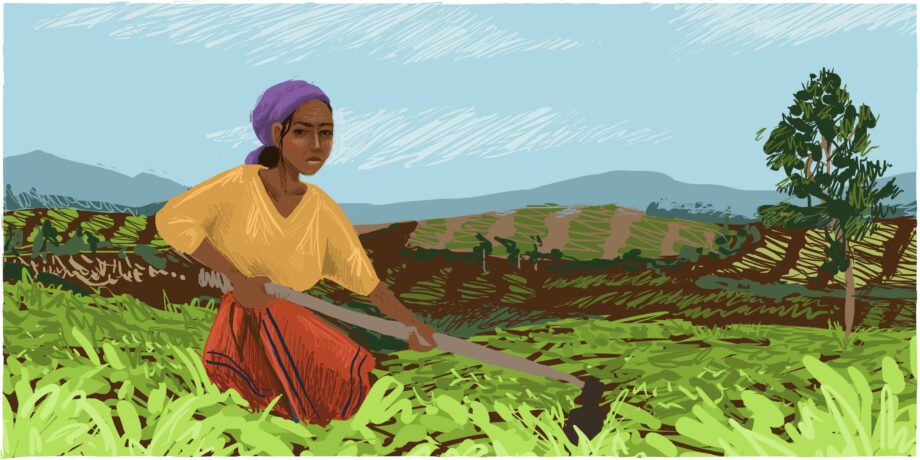November 12, 2014 — The 2008 global food price spikes were a wake-up call to global policy-makers, shaking them from the lethargic slumber of the overfed. The rhetorical responses were swift, but policies and practices have changed little. That is in part because they relied on the tried-and-failed solution of increasing commodity food production.
Agribusiness led the charge, with dire warnings about unsustainable population growth and looming resource constraints. How can we produce enough food to feed this growing population?
“Between now and 2050, we need to double the food supply,” said Robert Fraley, executive vice president and chief technology officer of Monsanto, during an interview with National Public Radio’s Takeaway host John Hockenberry. “That’s probably the greatest challenge facing mankind.”
Indeed, that was the theme of this year’s World Food Prize event, which took place October 15–17 in Des Moines, Iowa. The event promised more of the same solutions.
The panic is not warranted: The claims about the need to double food production are unfounded. According to ActionAid’s report, “Rising to the Challenge: Changing Course to Feed the World in 2050,” the solutions lie not in the rush to increase industrial food production but in supporting sustainable and productive farming practices among small-scale farmers — particularly women — in developing countries while halting the diversion of food to biofuels and reducing the obscene levels of waste and spoilage that keep one-third of the world’s food from nourishing anyone.
Sowing the Seeds of Panic
As the ActionAid report shows, reliable international projections from the United Nations suggest the need to increase global agricultural production — not food production — by 60 percent, not 100 percent, to feed a population of more than 9 billion by 2050. What’s more, they estimate that, with important caveats, we are on track to do just that. Yield improvements, land use changes and new investment should get us there, based on current trends.
The hungry are not hungry because the world lacks food.
For companies like Monsanto that sell agricultural inputs, producing more is indeed the solution to just about everything; after all, that lets them sell more seeds and chemicals. It is not surprising that Monsanto and other agribusiness firms might overstate the situation.
But if we can put aside the panic, maybe we can talk about our real problems, and they have everything to do with policy-makers’ fixation on throwing more high-yield industrial agriculture at the hunger problem. Why?
The hungry are not hungry because the world lacks food. We grow enough food right now to feed about 10 billion people, yet according to the U.N. nearly 1 billion of today’s 7 billion people are chronically undernourished and well over 1 billion suffer from significant malnutrition, in a world of plenty.
They are hungry because they are poor, and they are poor because they are (by and large) either small-scale farmers without enough land, credit, extension services or investment, or they are underemployed workers with incomes too low to support their families. Increasing the global supply of agricultural commodities might bring food prices down for a while, but it won’t feed the hungry.
The best area to invest in agriculture is small-scale farming, where the “yield gaps” are the largest and where hunger in the most prevalent.
What will? Public investment in sustainable small-scale food production in developing countries. Seventy percent of the hungry live in rural areas and rely primarily on agriculture for their livelihoods. A U.N. report confirmed that the best area to invest in agriculture is small-scale farming, where the “yield gaps” are the largest and where hunger in the most prevalent.
Yet policy-makers and multinational firms continue to promote large-scale industrial agricultural projects — some denounced as “land grabs” — such as those encouraged by the G8 countries’ New Alliance for Food Security and Nutrition. The U.N. Committee on World Food Security — or CFS — met in Rome this year to approve guidelines for responsible agricultural investment that can limit the most damaging impacts. Many displace small-scale farmers without their consent to grow export crops that offer few jobs and contribute nothing to local food security.
Such codes of conduct might stop the worst abuses, but they won’t bring the change in direction that we need, toward public investment in small-scale farmers using low-input, agroecological practices. This is consistent with the findings of an unprecedented 2009 multi-agency report that called for an end to “business as usual” policies.
Changing Course
There is no question that we need to continue to invest in appropriate technologies to enhance productivity, reduce environmental damage (including greenhouse gas emissions) and adapt to climate change. Public investment is crucial, and it has grown in the wake of the 2008 price spikes. So is private investment, which has responded to those high prices with a surge in investment that has driven prices below pre-crisis levels.
But if we’re going to achieve the goal of zero hunger, we have to change course. In addition to investing in climate-resilient small-scale agriculture, particularly with women farmers, we must:
- Stop diverting so much of our food and feed to biofuel production, which the National Academy of Sciences estimated was responsible for 20 to 40 percent of the 2008 price spikes. The Food and Agriculture Organization’s food projections do a poor job of incorporating biofuels, and biofuels are one of the leading nonfood uses of agricultural land. According to the International Energy Agency, crop-based biofuels demand will grow 150 percent by 2035 if we don’t change our policies. Government consumption mandates, such as the U.S. Renewable Fuel Standard, must be scaled back, an action that can do far more to keep food prices in check than investing in expanded agricultural commodity production.
- Reduce food waste and spoilage, which squanders one-third of all food grown in the world today. In the U.S., most of that waste is at the retail and consumer levels. In developing countries, it comes from poor storage, transportation and infrastructure, the very things that should be the focus of public investment. Earlier this year, CFS made recommendations based on a detailed U.N. report on the issue. Following them would do more to increase food availability, particularly for the hungry, than expanding commodity crop production.
It is time to stop the Malthusian fear-mongering. We can feed the world in 2050 if we change course and if we stop focusing only on producing more agricultural commodities. That has never solved the hunger problem. Instead, let’s increase the availability of land and food by reducing biofuel production, get more of the food we grow to the dinner table by reducing food waste, and invest in the most important food producers in the world: small-scale and family farmers. ![]()
Editor’s note: The views expressed here are those of the author and not necessarily of Ensia. We present them to further discussion around important topics. We encourage you to respond with a comment below, following our commenting guidelines, which can be found here. In addition, you might consider submitting a Voices piece of your own. See Ensia’s “Contact” page for submission guidelines.
This article originally appeared at Food Tank: The Food Think Tank. Read the original here.
Related: Read Food Tank co-founder and president Danielle Nierenberg’s “2014: The Year of Family Farming” on Ensia.
Ensia shares solutions-focused stories free of charge through our online magazine and partner media. That means audiences around the world have ready access to stories that can — and do — help them shape a better future. If you value our work, please show your support today.
Yes, I'll support Ensia!

